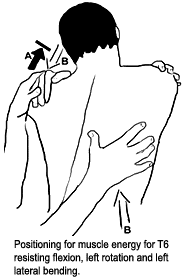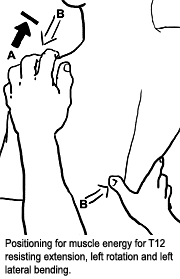Muscle energy is a technique developed by osteopaths. It has become widely used in both the chiropractic and physical therapy professions. It seems that most chiropractors think of muscle energy as a soft-tissue technique applied to muscles.
First, what is muscle energy? It's a somewhat confusing name for a technique. Is it energetic medicine? Is it using the muscles' energy? Muscle energy could be described as using postisometric relaxation to release muscles or joints. You put the patient in a position that isolates the area you want to stretch or release, have them contract the involved muscle in an isometric manner against resistance for three to five seconds, and then "stretch" or lengthen the involved tissue further. What you'll notice is that after the contraction, the restricted tissues seem to melt and release quite easily. Muscle energy can be used with precision to release and realign spinal joints from the atlas to the sacroiliac. Since I learned this technique about 10 years ago, it has become my primary method of adjusting the spine.
There are so many variations on how to use muscular contraction and movement to help release muscles and move joints. The hip adjustment I presented a few months ago - the "wishbone technique" from Lucy Whyte Ferguson - uses eccentric contraction as you move the hip joint. (Note: This hip work continues to profoundly impact my practice. Read more of my articles on this subject online: www.chiroweb.com/archives/25/10/11.html and www.chiroweb.com/archives/25/13/07.html.) Proprioceptive neuromuscular facilitation (PNF) is a whole series of movements using various types of resistance and motion. Active release from Leahy is another method that involves patient motion during the release.
Muscle energy is easy for us as chiropractors to understand. It's a direct technique - find the barrier and help move the joint through the barrier. Chiropractors are good at isolating the specific joint that is restricted. What do we lack? Most of us, due to our focus on HVLA, have a bit of a harsh touch that is a bit too firm for techniques such as muscle energy. In muscle energy, one of the keys is to not lock out the joint, but allow for motion. In a traditional adjustment, before you adjust you take the joint to the very end of the physiological motion barrier and then you thrust. In muscle energy, you take the joint only to the first soft barrier and then initiate the contract-relax cycle.
The advantages of muscle energy include the fact that it uses the patient's own muscular contraction to move the joint. This has a powerful training effect, subconsciously teaching the muscles to fire properly in order to move the involved joints. This is where the 10 percent to 20 percent firing of the muscle comes in. When you have the whole body leverage set up just right, have the patient gently contract - they will use mostly the small intrinsic spinal muscles. The goal is to get them to first contract and then relax the small key muscles. As patients usually do, they contract forcefully. If they make it a contest, they will fire the big spinal erectors and will not get the training effect or the proper localized motion.
The slower speed of muscle energy allows the soft tissue to stretch and release. Soft tissues can be stretched suddenly with traditional adjustments, but the quality of the change that occurs more slowly is really different. The best analogy I know is a boat stuck in the mud. If you push it suddenly, nothing happens. If you slowly lean into the boat, it begins to move and you can use that momentum to further movement. If you want to affect the soft tissues, you need to find a pace that matches that tissue. This doesn't mean it has to take forever; it does mean that gradual movement affects different tissues than thrust techniques do.
I have heard from so many patients, "I was so acute, in so much pain, in so much spasm, that Dr. X couldn't adjust me." This reflects such a narrow definition of the adjustment. Once you know low-force techniques, you can adjust anyone, anytime, no matter how acute, how much pain or spasm they are in, or how osteoporotic they are. (To review the basic principles of muscle energy assessment applied to the spinal joints, use the thoracic spine as a basic example. For further descriptions of the muscle energy approach for the thoracic spine, read my previous articles: www.chiroweb.com/archives/20/20/07.html and www.chiroweb.com/archives/20/23/10.html.)
Classic muscle energy uses a combination of visual and palpation indicators. Muscle energy has its own nomenclature regarding how it names or "lists" the lesions. I will not use this listing system, but instead use the language of motion palpation, identifying the directions that are resisted by the joint.
I recognize that writing and, even more so, reading about technique is inherently cumbersome. I hope some of you have the patience to wade through this and dig out the gems I have attempted to embed in this description. Apply this material right away, ideally with the article right in front of you, to really get it and make it your own.
What direction is limited? Muscle energy for individual segments looks for coupled motion patterns. The assumption for single segments in the thoracic or lumbar spine: When left lateral flexion is restricted, so is left rotation. You are looking at the vertebral body motion, not spinous process motion.
Here is an example with the patient seated and the practitioner seated behind them. Control the movement of the trunk with your left hand, in this case by grasping the left shoulder from above and behind. Push the right transverse of T6 from a posterior contact into left body rotation. At the same time, rotate the patient's whole trunk to the left, using both of your contacts. If the T6 vertebra resists left rotation, then by definition T6 also resists left lateral bending. You can be more exact about how significant the left lateral bending component is by contacting the left spinous process and laterally bending the patient's body around the fulcrum of your left spinous process of T6 contact.
Here is something that I don't think most chiropractors fully assess. You can add a determination of whether the T6 joint resists flexion or extension. As you rotate the transverse process of T6, you bias it either into flexion or into extension. If you are below the transverse and pushing upward, you are assessing flexion. If you are above the transverse and pushing inferior, you are testing extension. For extension, you also can use the opposite spinous process. Use your body movement and control the patient's movement to engage the whole region in this flexion vs. extension aspect of the motion, not just the spot you are touching.
 When you contact the inferior aspect of the same right transverse process (TP), ask the patient to gently slump forward through the areas of the spine that you are interested in so you can assess flexion. When they slump, does the TP resist the flexion motion? Does the tenderness increase over that TP as you push it in a superior direction? If T6 resists flexion, there will be a visual change as they slump forward. The left (opposite) TP will glide forward on the vertebrae below, and you will visually observe the spine rotate to the right as the right side is resisting this motion. This appears as a bump or high spot on the right side.
When you contact the inferior aspect of the same right transverse process (TP), ask the patient to gently slump forward through the areas of the spine that you are interested in so you can assess flexion. When they slump, does the TP resist the flexion motion? Does the tenderness increase over that TP as you push it in a superior direction? If T6 resists flexion, there will be a visual change as they slump forward. The left (opposite) TP will glide forward on the vertebrae below, and you will visually observe the spine rotate to the right as the right side is resisting this motion. This appears as a bump or high spot on the right side.
You can assess for lack of extension in a similar way. We'll use the lower thoracic as the example here. Your active contact, with your right thumb or pisiform, is on the left side of the spinous process of T12. Your other hand, as above, is on the top of the left shoulder. Your pressure is similar but significantly different. You'll have the patient gently extend - a good cue is "let your belly out toward the front." You'll pull the left shoulder inferior. Push the spinous process to the right, inducing (and testing for) left lateral bending. You also can use a transverse process contact on the superior border of the T12 transverse. Your anterior and inferior pressure on the right T12 TP induces both extension and left rotation, while your left-hand contact encourages extension, left lateral bending and left rotation. If the patient cannot tolerate much flexion or extension, you begin with the other movements (rotation and lateral bending) and then add slight flexion or extension at the end.
 I find this flexion/extension differentiation especially useful in the lumbar spine. When the patient is sitting, they generally have a bit of lumbar lordosis, which means any posterior-to-anterior pressure takes the spine into further extension. With a typical motion palpation type of scan, you will find segments that resist extension, but it's easy to miss segments that resist flexion. You need to get just below the mammillary process, have the patient slump through their lumbar spine and then push anterior and superior. You might find both tenderness and restriction, indicating a segment that resists flexion.
I find this flexion/extension differentiation especially useful in the lumbar spine. When the patient is sitting, they generally have a bit of lumbar lordosis, which means any posterior-to-anterior pressure takes the spine into further extension. With a typical motion palpation type of scan, you will find segments that resist extension, but it's easy to miss segments that resist flexion. You need to get just below the mammillary process, have the patient slump through their lumbar spine and then push anterior and superior. You might find both tenderness and restriction, indicating a segment that resists flexion.
When any of these assessments find significant restriction, you can go ahead and adjust using muscle energy. Use the same sitting positioning for correction as for assessment. In the examples above, have the patient lift up with their left shoulder, initiating right lateral flexion against your isometric resistance. You want to isolate the patient's motion to one plane, usually lateral bending, for simplicity. Instruct them to only gently contract and once they feel your resistance, to just hold at that point. The patient usually tries to contract too vigorously and then I'll cue them by saying "about one quarter as strong as that." They hold the contraction for 3 to 5 seconds. Then instruct them to relax and you allow/coax the vertebrae toward further left rotation, left lateral bending and either flexion or extension. Repeat two more times. As with any manual skill, it takes time to develop expertise in this.
To summarize, muscle energy can stand on its own as a complete adjustment, or can be used as a pre- or post-manipulative procedure to further release and retrain the joint and surrounding soft tissue.
Author's note: Thanks to David Panzer, DC, DABCO, and Charles Novak, MS, DC. This article was inspired by their presentations on muscle energy at the 8th Annual Northwest Chiropractic Symposium, sponsored by Western States Chiropractic College.
Click here for more information about Marc Heller, DC.





